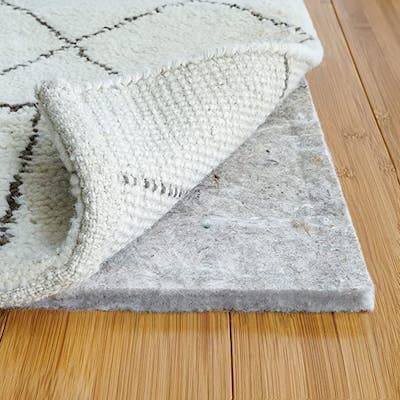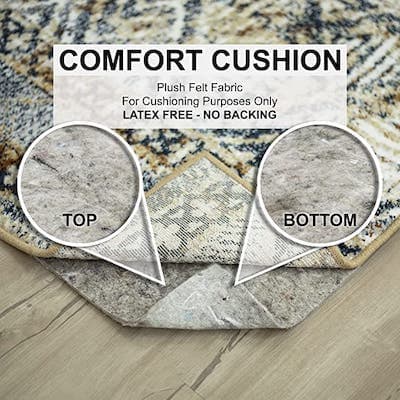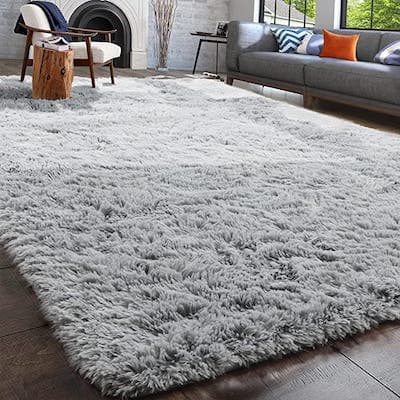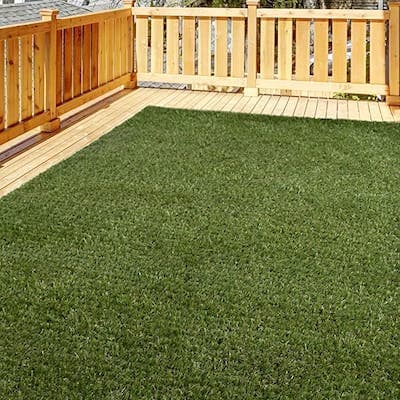Rug Pricing Guide: How Much Does a Rug Cost? What Is the Average Rug Price?
Rugs can be anything from a place to wipe your feet to a work of art. This also means the cost can be anywhere from the clearance rack at the Dollar Store to a luxury item in a high-end boutique store.
But what should you pay?
Many rugs are over-priced for what they are, and there’s also bargains out there. But when you’re buying a rug, how do you really know?
The easiest way to answer this question and understand rug prices is to break them up in price categories. Then, we’ll cover what to expect in each category.
Want to save on buying a rug? Consider checking out my blog post on how to make a rug with carpet remnants. It will take you through step-by-step including the exact equipment you need (it’s not much, and it’s cheap).
$5 to $25 rugs
The cheapest rugs are usually the smallest. In the ‘$25 and under’ rug price category you will find several 2×3 foot rugs.
While that size may sound small, it is actually the perfect size for an accent rug or a kitchen or bathroom rug. It is large enough to stand on and usually plush enough to be comfortable for long periods of time, such as while cooking or putting on makeup.
Most of these rugs are good for entryways where people wipe their feet, but you’ll also start to find some nicer small rugs that can go in a living room or bedroom.
$25 to $100 rugs
Expect bigger and heavier weight rugs in this category versus under $25. You’ll also start to notice a bit fancier or more luxurious looking designs, especially in the rugs closer to $100.
You don’t find hand-crafted rugs under $100, so these are still machine made. You’re also more likely to get a synthetic material, but there are some wool rugs in this price range.
This is my favorite category for casual rooms: living rooms, bedrooms, and some dining rooms. You’ll find durable rugs that are cheaper because they lack some of the artistic value of the higher-end rugs will discuss below.
$100 to $1,000 rugs
Expect most larger rugs—9×12, 8×10, etc—to be at this price point. Near the $500 price point and for smaller rugs, the words “handwoven” or “hand-textured” start to appear.
This price point spans a variety of rugs. The lower end you’ll find all-purpose medium to larger rugs. The middle of the price range you start to see smaller more artistic rugs, or larger, well-made all-purpose rugs. As you transition to the top dollar of this price range, you start to transition into the lower-end of the oriental rug spectrum.
With more expensive rugs, you pay for the time and effort that went into making them. Colors and patterns also grow more complex, both for handmade and machine-woven rugs. These rugs might not yet equal the appearance of the most expensive rugs but they do start to look a lot more unique.
These are rugs you may bring to a dining room to catch the eye and attract the viewer, or the living room. Some of the larger pieces also work well in the master bedroom, beneath or beside a king or queen-sized bed.
$1,000+ rugs
While expensive, it certainly is not unheard of for top quality rugs to be thousands of dollars. If you want to purchase a large oriental rug, you can pretty much expect it to be in this category. The same would apply to any large, handmade or handwoven rug for your living rooms.
These rugs are essentially pieces of art. They are large, often hand-woven with unique designs. This makes them not something to wipe your feet on, but a conversation piece in the middle of a formal room.
Due to their costs, these rugs are often as much for show as they are for use. Very few people would place them in a dining room, for example, because they are too fine to risk against an accidental slip of the wine glass.
As a result, the most expensive rugs are quite common in little-used formal living rooms, master bedrooms, and other less-traffic yet highly ornamental rooms.
What are the biggest contributors to rug prices?
The price ranges above give you an idea of what makes a rug more expensive, but let’s break it down. It’s important to know what you’re paying for, so you know when to spot a good or bad deal.
Materials
Generally speaking, natural fibers such as silk and cotton will be more expensive than man-made synthetic fibers such as nylon and polypropylene. Wool is one of the most expensive of the natural fibers, although silk is the norm for high-end Oriental rugs.
Natural fibers carry a certain fashion element to them, combining their authentic appearance and the psychological boost of being the “real thing.” Man-made fibers, on the other hand, are easy and inexpensive to produce en masse, and usually are then woven into rugs within a factory setting which can produce dozens of rugs a day, compared to a handmade rug taking dozens of people hours to craft.
Size
As you can see from the pricing guide above, when all else is equal the least expensive rugs will be small and the most expensive will be large. Some people see this as a reason not to go with the largest rug possible in the space but that isn’t always the best solution either. A too-small rug in a large space will look isolated and out of place.
Hand-made and overall construction
Knot count is a common conveyor of quality, just as thread count is for sheets. It refers to the number of knots woven into it per square inch. For Oriental rugs, it’s a pretty direct correlation to its cost.
For example, most Oriental rugs will have a knot count between 7/7 and 16/16, and average around 9/9. The higher that number, however, the more time and material has gone into making it plush and pliable, so you can definitely expect it to impact the final price tag.
 Captain’s warning!Another note on construction. Some companies cut costs by employing child labor to produce their rugs quickly and cheaply. To keep them from profiting by this practice, you should look into the companies that make the “imported” rugs to verify that they are doing so in a sustainable and humane manner.
Captain’s warning!Another note on construction. Some companies cut costs by employing child labor to produce their rugs quickly and cheaply. To keep them from profiting by this practice, you should look into the companies that make the “imported” rugs to verify that they are doing so in a sustainable and humane manner.Style
The prices and styles can come and go with the ever-shifting winds of fashion. Style does play a major role, however, in the cost of an area rug. Different brands and looks might come into vogue and that will drive up the costs, then as new ones become popular those will decline in price according to demand.
The style also plays a role in the knot count and can give a clue as to the expected cost of the final product. A flat weave rug uses fewer knots per square inch, so it is less expensive and less soft to the touch.
Overall quality
Some of the most expensive rugs you will find on the market are expected to be passed down through generations as a family heirloom. These are usually handwoven rugs, imported, and expertly crafted with patterns, dyes, and sheen unlike any found off a factory floor. Since they are, essentially, a work of art, their prices will reflect their value.
Captain’s parting words!
Hopefully, you now know whether you’re getting a steal of deal or over-paying.
If you want more help picking your rug, check out my unbiased rug guide. It will help you decide rug material, placement, size, and more.
Any other questions on area rug prices? Let me know in the comments below.
 |
 |
 |
 |
 |
|---|---|---|---|---|
| RUGPADUSA Cushioning Rug Pad | Peel & Stick Carpet Tiles (12 sf) | Mohawk Home Rug Pad | PAGISOFE Fluffy Area Rug | Faux Thick Realistic Grass Mats & Rugs |
| 4.5 18500+ ratings |
4.7 1100+ ratings |
4.5 12500+ ratings |
4.3 2000+ ratings |
4.5 1800+ ratings |
| $25 - $100 | $10 - $25 | $50 - $125 | $25 - $75 | $50 - $150 |


on average how much should I discount an $,8000 contemporary rug that is in excellent condition